Proceedings Articles
|
2017
|
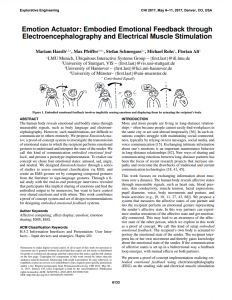 | Mariam Hassib; Max Pfeiffer; Stefan Schneegass; Michael Rohs; Florian Alt Emotion Actuator: Embodied Emotional Feedback Through Electroencephalography and Electrical Muscle Stimulation Proceedings Article In: Proceedings of the 2017 CHI Conference on Human Factors in Computing Systems, pp. 6133–6146, ACM, Denver, Colorado, USA, 2017, ISBN: 978-1-4503-4655-9. @inproceedings{Hassib:2017:EAE:3025453.3025953,
title = {Emotion Actuator: Embodied Emotional Feedback Through Electroencephalography and Electrical Muscle Stimulation},
author = {Mariam Hassib and Max Pfeiffer and Stefan Schneegass and Michael Rohs and Florian Alt},
url = {http://amp.ubicomp.net/wp-content/uploads/2018/03/pubpdf-p6133-hassib-emotion_actuator.pdf},
doi = {10.1145/3025453.3025953},
isbn = {978-1-4503-4655-9},
year = {2017},
date = {2017-01-01},
booktitle = {Proceedings of the 2017 CHI Conference on Human Factors in Computing Systems},
pages = {6133--6146},
publisher = {ACM},
address = {Denver, Colorado, USA},
series = {CHI '17},
abstract = {The human body reveals emotional and bodily states through measurable signals, such as body language and electroencephalography. However, such manifestations are difficult to communicate to others remotely. We propose EmotionActuator, a proof-of-concept system to investigate the transmission of emotional states in which the recipient performs emotional gestures to understand and interpret the state of the sender.We call this kind of communication embodied emotional feedback, and present a prototype implementation. To realize our concept we chose four emotional states: amused, sad, angry, and neutral. We designed EmotionActuator through a series of studies to assess emotional classification via EEG, and create an EMS gesture set by comparing composed gestures from the literature to sign-language gestures. Through a final study with the end-to-end prototype interviews revealed that participants like implicit sharing of emotions and find the embodied output to be immersive, but want to have control over shared emotions and with whom. This work contributes a proof of concept system and set of design recommendations for designing embodied emotional feedback systems.},
keywords = {},
pubstate = {published},
tppubtype = {inproceedings}
}
The human body reveals emotional and bodily states through measurable signals, such as body language and electroencephalography. However, such manifestations are difficult to communicate to others remotely. We propose EmotionActuator, a proof-of-concept system to investigate the transmission of emotional states in which the recipient performs emotional gestures to understand and interpret the state of the sender.We call this kind of communication embodied emotional feedback, and present a prototype implementation. To realize our concept we chose four emotional states: amused, sad, angry, and neutral. We designed EmotionActuator through a series of studies to assess emotional classification via EEG, and create an EMS gesture set by comparing composed gestures from the literature to sign-language gestures. Through a final study with the end-to-end prototype interviews revealed that participants like implicit sharing of emotions and find the embodied output to be immersive, but want to have control over shared emotions and with whom. This work contributes a proof of concept system and set of design recommendations for designing embodied emotional feedback systems. |
 | Sarah Clinch; Tilman Dingler; Kai Kunze; Passant ElAgroudy; Tsutomu Terada WAHM - 4th Workshop on Ubiquitous Technologies to Augment the Human Mind: Sharing Experiences Proceedings Article In: Proceedings of the 2017 ACM International Joint Conference on Pervasive and Ubiquitous Computing and Proceedings of the 2017 ACM International Symposium on Wearable Computers, pp. 662–665, ACM, Maui, Hawaii, 2017, ISBN: 978-1-4503-5190-4. @inproceedings{Clinch:2017:WWU:3123024.3124459,
title = {WAHM - 4th Workshop on Ubiquitous Technologies to Augment the Human Mind: Sharing Experiences},
author = {Sarah Clinch and Tilman Dingler and Kai Kunze and Passant ElAgroudy and Tsutomu Terada},
url = {http://amp.ubicomp.net/wp-content/uploads/2018/03/pubpdf-p662-clinch.pdf},
doi = {10.1145/3123024.3124459},
isbn = {978-1-4503-5190-4},
year = {2017},
date = {2017-01-01},
booktitle = {Proceedings of the 2017 ACM International Joint Conference on Pervasive and Ubiquitous Computing and Proceedings of the 2017 ACM International Symposium on Wearable Computers},
pages = {662--665},
publisher = {ACM},
address = {Maui, Hawaii},
series = {UbiComp '17},
abstract = {A recurring science fiction theme is the downloading of abilities from another human to one's own mind. Emerging technologies beyond simple audio/video recordings such as: 360° videos, tactile recorders and odor recorders are promising tools to enable skill transfer and empathy. However, the produced large datasets require new means for selecting, displaying and sharing experiences. This workshop will bring together researchers from a wide range of computing disciplines, such as virtual reality, mobile computing, privacy and security, social computing and ethnography, usability, and systems research. Furthermore, we will invite researchers from related disciplines such as psychology and economics. The objective is to discuss how these trends are changing our existing research on sharing experiences and knowledge to augment the human mind.},
keywords = {},
pubstate = {published},
tppubtype = {inproceedings}
}
A recurring science fiction theme is the downloading of abilities from another human to one's own mind. Emerging technologies beyond simple audio/video recordings such as: 360° videos, tactile recorders and odor recorders are promising tools to enable skill transfer and empathy. However, the produced large datasets require new means for selecting, displaying and sharing experiences. This workshop will bring together researchers from a wide range of computing disciplines, such as virtual reality, mobile computing, privacy and security, social computing and ethnography, usability, and systems research. Furthermore, we will invite researchers from related disciplines such as psychology and economics. The objective is to discuss how these trends are changing our existing research on sharing experiences and knowledge to augment the human mind. |
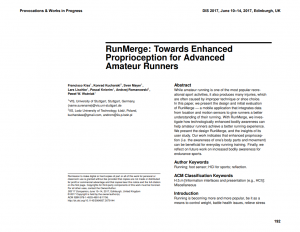 | Francisco Kiss; Konrad Kucharski; Sven Mayer; Lars Lischke; Pascal Knierim; Andrzej Romanowski; Paweł W Wozniak RunMerge: Towards Enhanced Proprioception for Advanced Amateur Runners Proceedings Article In: Proceedings of the 2017 ACM Conference Companion Publication on Designing Interactive Systems, pp. 192–196, ACM, Edinburgh, United Kingdom, 2017, ISBN: 978-1-4503-4991-8. @inproceedings{Kiss:2017:RTE:3064857.3079144,
title = {RunMerge: Towards Enhanced Proprioception for Advanced Amateur Runners},
author = {Francisco Kiss and Konrad Kucharski and Sven Mayer and Lars Lischke and Pascal Knierim and Andrzej Romanowski and Paweł W Wozniak},
url = {http://amp.ubicomp.net/wp-content/uploads/2018/03/pubpdf-p192-kiss.pdf},
doi = {10.1145/3064857.3079144},
isbn = {978-1-4503-4991-8},
year = {2017},
date = {2017-01-01},
booktitle = {Proceedings of the 2017 ACM Conference Companion Publication on Designing Interactive Systems},
pages = {192--196},
publisher = {ACM},
address = {Edinburgh, United Kingdom},
series = {DIS '17 Companion},
abstract = {While amateur running is one of the most popular recreational sport activities, it also produces many injuries, which are often caused by improper technique or shoe choice. In this paper, we present the design and initial evaluation of RunMerge - a mobile application that integrates data from location and motion sensors to give runners a better understanding of their running. With RunMerge, we investigate how technologically enhanced bodily awareness can help amateur runners achieve a better running experience. We present the design RunMerge, and the insights of its user study. Our work indicates that enhanced proprioception (i.e. the awareness of one's body parts and movement) can be beneficial for everyday running training. Finally, we reflect on future work on increased bodily awareness for endurance sports.},
keywords = {},
pubstate = {published},
tppubtype = {inproceedings}
}
While amateur running is one of the most popular recreational sport activities, it also produces many injuries, which are often caused by improper technique or shoe choice. In this paper, we present the design and initial evaluation of RunMerge - a mobile application that integrates data from location and motion sensors to give runners a better understanding of their running. With RunMerge, we investigate how technologically enhanced bodily awareness can help amateur runners achieve a better running experience. We present the design RunMerge, and the insights of its user study. Our work indicates that enhanced proprioception (i.e. the awareness of one's body parts and movement) can be beneficial for everyday running training. Finally, we reflect on future work on increased bodily awareness for endurance sports. |
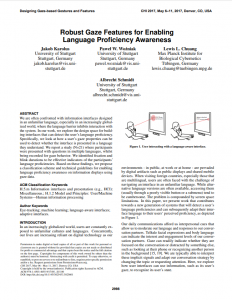 | Jakob Karolus; Paweł W Wozniak; Lewis L Chuang; Albrecht Schmidt Robust Gaze Features for Enabling Language Proficiency Awareness Proceedings Article In: Proceedings of the 2017 CHI Conference on Human Factors in Computing Systems, pp. 2998–3010, ACM 2017. @inproceedings{karolus2017robust,
title = {Robust Gaze Features for Enabling Language Proficiency Awareness},
author = {Jakob Karolus and Pawe{ł} W Wozniak and Lewis L Chuang and Albrecht Schmidt},
url = {http://amp.ubicomp.net/wp-content/uploads/2018/03/pubpdf-p2998-karolus-reduced-size.pdf},
doi = {10.1145/3025453.3025601},
year = {2017},
date = {2017-01-01},
booktitle = {Proceedings of the 2017 CHI Conference on Human Factors in Computing Systems},
pages = {2998--3010},
organization = {ACM},
abstract = {We are often confronted with information interfaces designed in an unfamiliar language, especially in an increasingly globalized world, where the language barrier inhibits interaction with the system. In our work, we explore the design space for building interfaces that can detect the user's language proficiency. Specifically, we look at how a user's gaze properties can be used to detect whether the interface is presented in a language they understand. We report a study (N=21) where participants were presented with questions in multiple languages, whilst being recorded for gaze behavior. We identified fixation and blink durations to be effective indicators of the participants' language proficiencies. Based on these findings, we propose a classification scheme and technical guidelines for enabling language proficiency awareness on information displays using gaze data.},
keywords = {},
pubstate = {published},
tppubtype = {inproceedings}
}
We are often confronted with information interfaces designed in an unfamiliar language, especially in an increasingly globalized world, where the language barrier inhibits interaction with the system. In our work, we explore the design space for building interfaces that can detect the user's language proficiency. Specifically, we look at how a user's gaze properties can be used to detect whether the interface is presented in a language they understand. We report a study (N=21) where participants were presented with questions in multiple languages, whilst being recorded for gaze behavior. We identified fixation and blink durations to be effective indicators of the participants' language proficiencies. Based on these findings, we propose a classification scheme and technical guidelines for enabling language proficiency awareness on information displays using gaze data. |
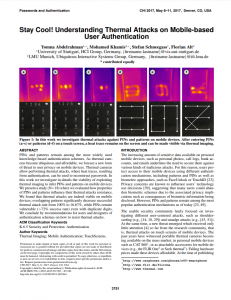 | Yomna Abdelrahman; Mohamed Khamis; Stefan Schneegass; Florian Alt Stay Cool! Understanding Thermal Attacks on Mobile-based User Authentication Proceedings Article In: Proceedings of the 2017 CHI Conference on Human Factors in Computing Systems, pp. 3751–3763, ACM, Denver, Colorado, USA, 2017, ISBN: 978-1-4503-4655-9. @inproceedings{Abdelrahman:2017:SCU:3025453.3025461,
title = {Stay Cool! Understanding Thermal Attacks on Mobile-based User Authentication},
author = {Yomna Abdelrahman and Mohamed Khamis and Stefan Schneegass and Florian Alt},
url = {http://amp.ubicomp.net/wp-content/uploads/2018/03/pubpdf-p3751-abdelrahman-stay_cool.pdf},
doi = {10.1145/3025453.3025461},
isbn = {978-1-4503-4655-9},
year = {2017},
date = {2017-01-01},
booktitle = {Proceedings of the 2017 CHI Conference on Human Factors in Computing Systems},
pages = {3751--3763},
publisher = {ACM},
address = {Denver, Colorado, USA},
series = {CHI '17},
abstract = {PINs and patterns remain among the most widely used knowledge-based authentication schemes. As thermal cameras become ubiquitous and affordable, we foresee a new form of threat to user privacy on mobile devices. Thermal cameras allow performing thermal attacks, where heat traces, resulting from authentication, can be used to reconstruct passwords. In this work we investigate in details the viability of exploiting thermal imaging to infer PINs and patterns on mobile devices. We present a study (N=18) where we evaluated how properties of PINs and patterns influence their thermal attacks resistance. We found that thermal attacks are indeed viable on mobile devices; overlapping patterns significantly decrease successful thermal attack rate from 100% to 16.67%, while PINs remain vulnerable (>72% success rate) even with duplicate digits. We conclude by recommendations for users and designers of authentication schemes on how to resist thermal attacks.},
keywords = {},
pubstate = {published},
tppubtype = {inproceedings}
}
PINs and patterns remain among the most widely used knowledge-based authentication schemes. As thermal cameras become ubiquitous and affordable, we foresee a new form of threat to user privacy on mobile devices. Thermal cameras allow performing thermal attacks, where heat traces, resulting from authentication, can be used to reconstruct passwords. In this work we investigate in details the viability of exploiting thermal imaging to infer PINs and patterns on mobile devices. We present a study (N=18) where we evaluated how properties of PINs and patterns influence their thermal attacks resistance. We found that thermal attacks are indeed viable on mobile devices; overlapping patterns significantly decrease successful thermal attack rate from 100% to 16.67%, while PINs remain vulnerable (>72% success rate) even with duplicate digits. We conclude by recommendations for users and designers of authentication schemes on how to resist thermal attacks. |
Journal Articles
|
2016
|
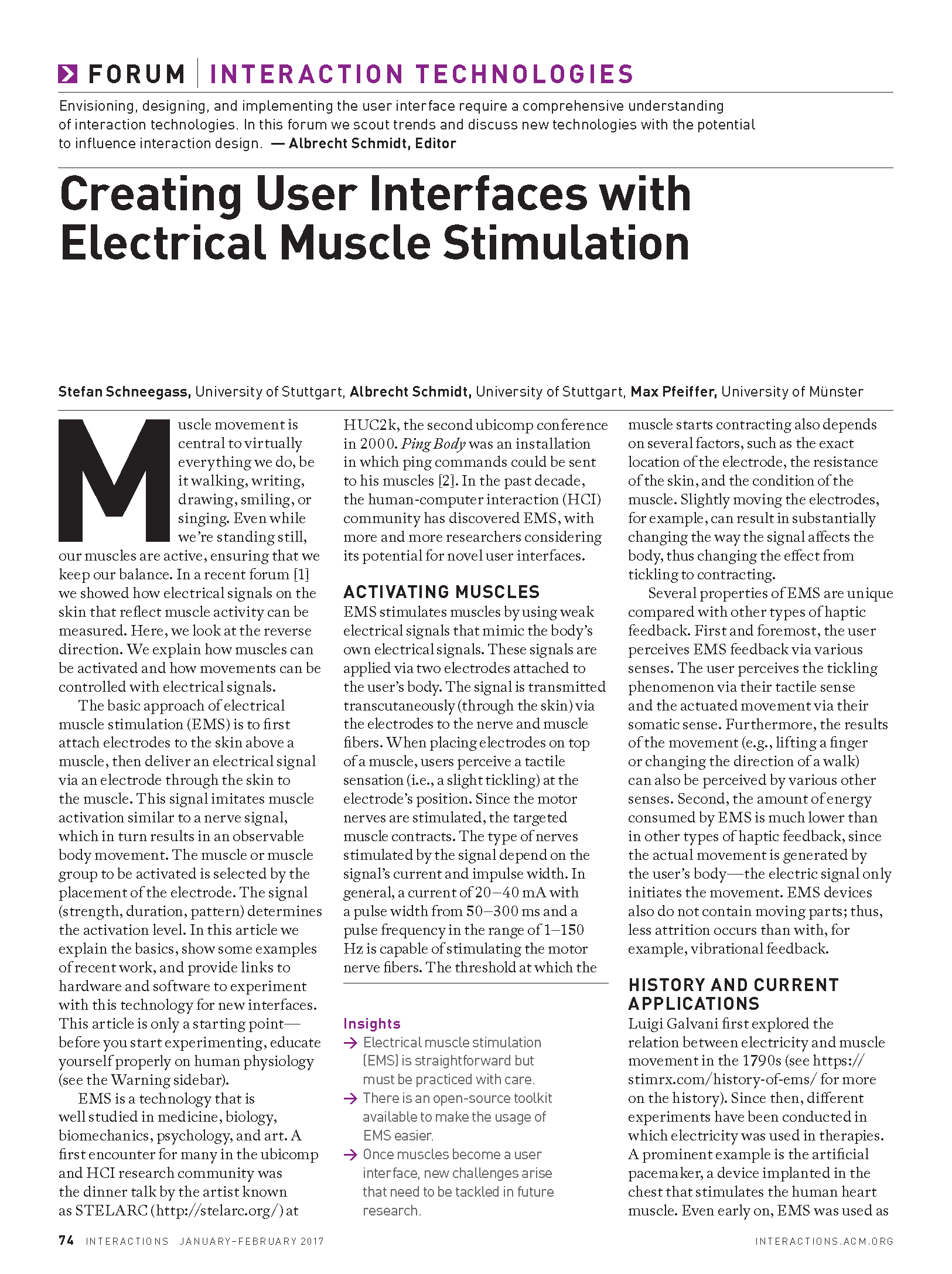 | Stefan Schneegass; Albrecht Schmidt; Max Pfeiffer Creating user interfaces with electrical muscle stimulation Journal Article In: interactions, vol. 24, no. 1, pp. 74–77, 2016, ISSN: 10725520. @article{Schneegass2016,
title = {Creating user interfaces with electrical muscle stimulation},
author = {Stefan Schneegass and Albrecht Schmidt and Max Pfeiffer},
url = {http://amp.ubicomp.net/wp-content/uploads/2019/05/Schneegass-Schmidt-Pfeiffer-2016-Creating-user-interfaces-with-electrical-muscle-stimulation.pdf},
doi = {10.1145/3019606},
issn = {10725520},
year = {2016},
date = {2016-12-01},
journal = {interactions},
volume = {24},
number = {1},
pages = {74--77},
publisher = {ACM},
keywords = {},
pubstate = {published},
tppubtype = {article}
}
|
| Stefan Schneegass; Albrecht Schmidt; Max Pfeiffer Creating user interfaces with electrical muscle stimulation Journal Article In: Interactions, vol. 24, no. 1, pp. 74–77, 2016. @article{Schneegass_2016,
title = {Creating user interfaces with electrical muscle stimulation},
author = {Stefan Schneegass and Albrecht Schmidt and Max Pfeiffer},
url = {https://doi.org/10.1145%2F3019606},
doi = {10.1145/3019606},
year = {2016},
date = {2016-12-01},
journal = {Interactions},
volume = {24},
number = {1},
pages = {74–77},
publisher = {Association for Computing Machinery (ACM)},
keywords = {},
pubstate = {published},
tppubtype = {article}
}
|






